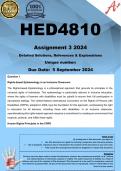HED4810
Assignment 3 2024
Detailed Solutions, References & Explanations
Unique number:
Due Date: 5 September 2024
Question 1
Rights-based Epistemology in an Inclusive Classroom
The Rights-based Epistemology is a philosophical approach that grounds its principles in the
universal rights of individuals. This epistemology is particularly relevant in inclusive education,
where the rights of learners with disabilities must be upheld to ensure their full participation in
educational settings. The United Nations International Convention on the Rights of Persons with
Disabilities (CRPD), adopted in 2006, lays the foundation for this approach, emphasizing the right
to education for all learners, including those with disabilities. In an inclusive classroom,
operationalizing this rights-based approach requires a commitment to creating an environment that
respects, protects, and fulfills these rights.
Human Rights Principles in the CRPD
The CRPD outlines several human rights principles that are critical to inclusive education. Among
these principles are:
Terms of use
1. Non-discrimination: This principle emphasizes thatByall individuals,
making use of thisregardless
document youof their
agree to:
• Use this document as a guide for learning, comparison and reference purpose,
abilities, should have equal access to education without any form of discrimination. In an
• Not to duplicate, reproduce and/or misrepresent the contents of this document as your own work,
inclusive classroom, this •principle is operationalized
Fully accept the consequencesby ensuring
should that allorlearners,
you plagiarise misuse thisincluding
document.
those with disabilities, have access to the same educational opportunities. For example, a
Disclaimer
teacher Extreme
might care
provide adapted
has been learning
used to create materials,
this document, suchthe
however ascontents
Braillearetextbooks
provided “asor
is” audio
without
any representations or warranties, express or implied. The author assumes no liability as a result of
recordings, forand
reliance visually impaired
use of the contentslearners to ensure
of this document. Thisthey can access
document the for
is to be used curriculum like
comparison, their
research
peers. and reference purposes ONLY. No part of this document may be reproduced, resold or transmitted in any
form or by any means.




